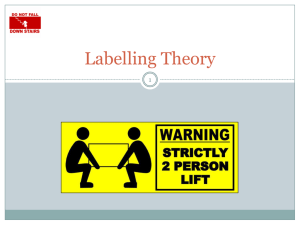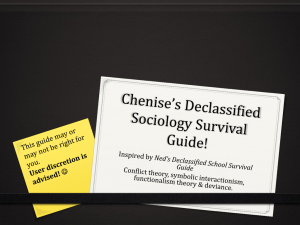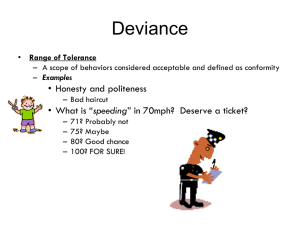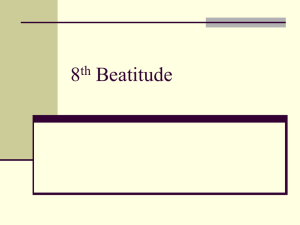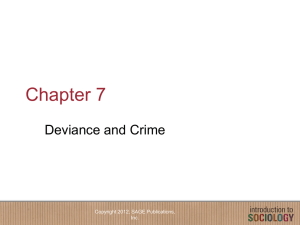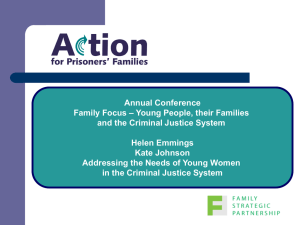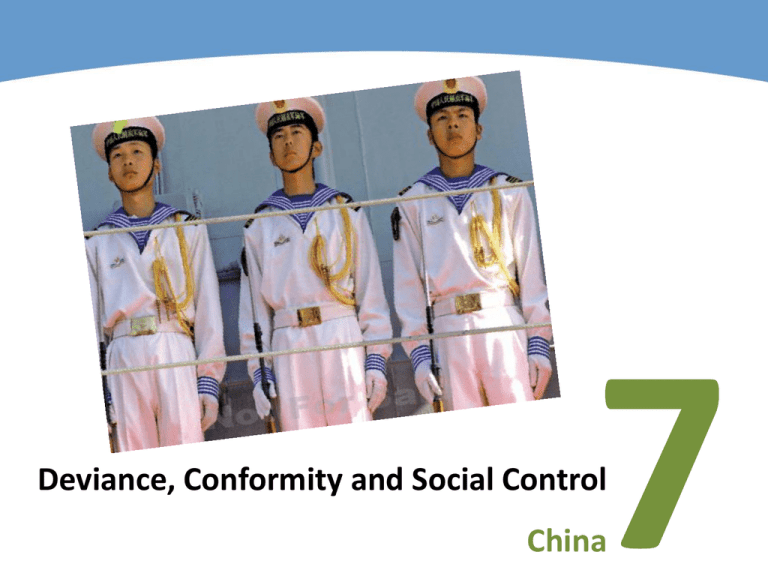
Deviance, Conformity and Social Control
China
Why China?
1. Many behaviors that constituted deviance in China from
1966 to 1976, the period known as the Cultural
Revolution, are no longer judged that way.
2. During the Cultural Revolution, any person
who held a position of authority
worked to earn a profit
showed the slightest leaning toward foreign ways
expressed academic interests
was subject to interrogation, arrest, and punishment.
3. China has transformed itself to become a global center of
manufacturing for everything from electronics to socks
and toys.
Deviance…
•Any behavior or physical appearance that is socially
challenged and or condemned because it departs from the
norms and expectations of a group
•What makes something deviant is the presence of a social
audience that regards a behavior or appearance as deviant
and takes some kind of action
to discourage it
to show disapproval
to put those labeled deviant on the defensive
•Norms: rules and expectations for the way people are
supposed to behave, feel, and appear in a particular social
situation
Norm: We expect boys not to wear princess outfits.
People may
ostracize the
mother for
allowing her son
to dress in a
princess outfit.
Social Control
•
•
•
•
Socialization may control deviant behavior
Sanctions act as social control
Positive sanction – approval to encourage compliance
Negative sanction – disapproval to encourage
compliance
• Informal sanction – making fun, showing disapproval,
clapping to approve
• Formal Sanction – backed by laws, policies, rules
• Censorship – blocking material from getting to people
Sociological Theories
• Functionalist theory – deviance must exist because
collective norms exist in society
– Deviance binds community, and allows for change
• Labeling Theory –
• An act is only deviant when people notice it and label
it as such
• Rules are socially constructed
• Rules are not enforced equally
– rule breaking may not be noticed
- some are falsely accused – viewed differently
Stanley Milgram
• Obedience to authority experiment at Yale
– Members of the public were recruited to test if
punishment helped people learn
– Participants gave varying strength electric shocks to
learners
– 65% obeyed the authority figure of the professor
wearing the white coat, and complied with instructions
to continue on to giving a 450 volt (potentially fatal) to
learners
Structural Strain Theory
• Robert K. Merton (1957) – structural strain occurs when
– The valued goals of society have unclear limits
– People are unsure about whether they can attain goals
legitimately
– A large portion of the population cannot achieve goals
through legitimate means
• People might therefore break rules and laws or create new
sub groups where they can achieve goals
• Example: falsifying your resume to get a job
• Also, read about families having children in China - p171174
Sociological Perspective
Deviance is not inherent in any act, appearance, or
behavior, it is sociologically constructed
• Emphasis is placed on the context in which some
behavior or appearance is defined as deviant
– For example, in China it is considered deviant to
have more than one child
• Why focus on the context in which deviant behavior
occurs?
Reason 1:
Something considered deviant at one time and
place may not be considered deviant at
another time and place.
Reason 2:
Under the right circumstances, almost
any behavior can qualify as deviant.
economic crisis
health crisis
national security crisis
other social crisis
Reason 3:
Secret deviants
•People who break rules and escape detection
Falsely accused deviants
•People treated as deviant even though they
have broken no rules
Conformists and Deviants
• For every rule a social group creates, four
categories of people exist:
– Conformists – those who obey rules
– Pure deviants – those who break rules, are
accused and ostracized for being deviant
– Secret deviants – people where deviance is not
noticed or where people look the other way
– Falsely accused – those who are not guilty but
who are accused of deviance
The Status of Deviant
Primary deviants
Those people whose rule breaking is viewed as
understandable, incidental, or insignificant in light of
some socially approved status they hold – teen
vandalism
Secondary deviants
Those whose rule breaking is treated as something so
significant that it cannot be overlooked or explained
away – adult sex with minors
Master status of deviant
Those whose deviance overrides any other aspect of
their lives – e.g. convicts
Cultural Revolution (1966-1976)
A struggle for power within the Chinese Communist
Party that resulted in dramatic social, political, and
economic chaos
Specifically, the Cultural Revolution was an attempt by
Mao Zedong to eliminate anyone in the Communist
Party and in the masses who opposed his policies
Socially Challenged Behaviors During the Cultural
Revolution (that are not challenged today in China)
Withdrawing money from Speaking a foreign language
a bank
Owning a camera or radio
Making a profit
Traveling abroad
Occupying a position of
Being a scientist, teacher,
authority
athlete, performer, artist,
Having an academic
business owner
interest
Having relatives who live
Wearing makeup
outside of China
Wearing glasses
The Incarceration Crisis in the USA
The International Centre of Prison Studies statistics on numbers of individuals in prison
New York times on Crime in the USA
Race and Crime
1.While people of color make up about 30 percent of the United States’
population, they account for 60 percent of those imprisoned. The prison
population grew by 700 percent from 1970 to 2005, a rate that is outpacing
crime and population rates. The incarceration rates disproportionately impact
men of color: 1 in every 15 African American men and 1 in every 36 Hispanic
men are incarcerated in comparison to 1 in every 106 white men.
2.According to the Bureau of Justice Statistics, one in three black men can
expect to go to prison in their lifetime. Individuals of color have a
disproportionate number of encounters with law enforcement, indicating
that racial profiling continues to be a problem. A report by the Department of
Justice found that blacks and Hispanics were approximately three times more
likely to be searched during a traffic stop than white motorists. African
Americans were twice as likely to be arrested and almost four times as likely
to experience the use of force during encounters with the police.
http://www.americanprogress.org/issues/race/news/2012/03/13/11351/the-top-10-most-startling-factsabout-people-of-color-and-criminal-justice-in-the-united-states/
The Cost of Imprisonment
http://www.vera.org/pubs/price-prisons
The Cost of Imprisonment
http://www.vera.org/pubs/price-prisons
TOTAL TAXPAYER COST PER INMATE
Among the 40 states surveyed, representing more than 1.2 million
inmates (of 1.4 million total people incarcerated in all 50 state prison
systems), the total per-inmate cost averaged $31,286 and ranged from
$14,603 in Kentucky to $60,076 in New York (see Figure 4).9 The
methodology provides an “apples to apples” comparison of state prison
costs because it standardizes the measure and counts the
comprehensive costs to taxpayers in every state.
The value of such a comparison is clear: corrections officials understand
that prison costs are counted differently in every state. In the course of
this study, for example, a Florida Department of Corrections official told
interviewers that the department is often asked why its costs appear to
be higher than those of other states. The answer is, in part, because
Florida measures prison costs more comprehensively than some other
states do, because relatively few of its prison costs are outside the
http://www.vera.org/pubs/price-prisons
corrections budget.
The Impact of Imprisonment on Society
Incarceration
The USA has the largest prison population in the world. The prison
population does not reflect the general population, with a far
higher percentage of Hispanics and African Americans in prison
White collar crimes
These are crimes committed by people in higher status positions.
They cost the USA an estimated $300 billion annually,
(http://www.law.cornell.edu/wex/white-collar_crime), yet many
complain that they are treated less harshly than crimes committed
by people with less status in society
The Impact of Imprisonment on Society
Mental Health
More than half of US prisoners have symptoms of mental health
problems, including major mental health diagnoses,
(http://www.hrw.org/news/2006/09/05/us-number-mentally-illprisons-quadrupled), yet prisons do not provide adequate care and
treatment for inmates with mental health problems. One report states
that there are three times as many individuals with mental health
problems in prison, in comparison to mental health hospitals.
http://www.unhcr.org/refworld/publisher,HRW,,USA,3fe482a57,0.html
http://www.hrw.org/news/2009/09/22/mental-illness-human-rightsand-us-prisons
http://www.msnbc.msn.com/id/14707120/ns/healthmental_health/t/survey-most-inmates-show-mentalsymptoms/#.UOm7Kbar_Oc
Alternatives to Imprisonment
Much research shows that prison does not work and that many
convicts return to prison, since they are not prepared to function in
the real world, while incarcerated. As well as people with addictions,
and mental health diagnoses, a disproportionate number of homeless
people end up in prison. There are not enough drug treatment
programs, or job and education training in prison.
Many studies point towards the effectiveness of community based
programs, in contrast to imprisonment for non-violent offenders.
http://www.nytimes.com/2012/11/28/opinion/invitation-to-a-dialogue-alternatives-to-prison.html?_r=0
http://www.cbsnews.com/8301-3445_162-57418495/the-cost-of-a-nation-of-incarceration/



